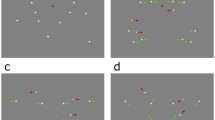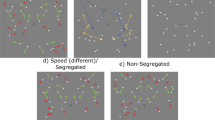Summary
When a circular disc with an eccentric dot painted on it is set in slow circular motion, a three-dimensional solid object appears to the observer: the stereokinetic cone. The cone shows a well-defined height and tilt. All current theories of how the visual system can extract 3-D percepts from 2-D moving patterns, are based on a “rigidity assumption” hypothesis. But this assumption cannot explain why the stereokinetic cone appears to have a well-defined height. An alternative hypothesis is proposed here, which avoids the rigidity assumption and is based on a minimization process of the relative velocity differences between all the points of the rotating pattern. The hypothesis allows a quantitative prediction of the stereokinetic cone height both when the rotating disc is circular and when it is elliptical. The predictions are in good agreement with previously reported experimental results and with our own observations.
Similar content being viewed by others
References
Braunstein, M. L., & Andersen, G. J. (1984). A counter example to the rigidity assumption in the visual perception of structure from motion. Perception, 13, 213–217.
Beghi, L., Vicario, G., & Zanforlin, M. (1984). The perceptual centre of visual configurations. Accademia Patavina di Scienze, Lettere ed Arti, XCV (1982–83), III, 133–148.
Carlson, V. R. (1977). Instruction and perceptual Constancy judgements. In: W. Epstein (Ed.), Stability and constancy in visual perception (pp. 217–254). New York: Wiley.
Cutting, J. E. (1986). Perception with an eye for motion. Cambridge, Mass.: MIT Press.
Cutting, J. E. (1987). Perception and information. Annual Review of Psychology, 38, 61–90.
Cutting, D. R., & Proffitt, D. R. (1982). The minimum principle and the perception of absolute, common, and relative motions. Cognitive Psychology, 14, 211–246.
Duncker, K. (1929). Über induzierte Bewegung. Ein Beitrag zur Theorie optischer wahrgenommener Bewegung. Psychologische Forschung, 12, 159–180.
Epstein, W. (1961). The known-size-apparent-distance hypothesis. American Journal of Psychology, 74, 333–346.
Eriksson, E. S. (1974). A theory of veridical space perception. Scandinavian Journal of Psychology, 15, 225–235.
Fischer, G. T. (1956). Factors affecting estimation of depth with variation of the stereokinetic effect. American Journal of Psychology, 69, 252–257.
Gibson, J. J. (1958). What gives rise to the perception of motion? Psychological Review, 75, 335–345.
Gogel, W. C. (1977). The metric of visual space. In: W. Epstein (Ed.), Stability and constancy in visual perception (pp. 129–181). New York: Wiley.
Hildred, E. C. (1984). Computations underlying the measurement of visual motion. Artificial Intelligence, 23, 309–354.
Hopfield, J. J., & Tank, D. W. (1986). Computing with neural circuits. Science, 233, (4764), 625–633.
Johansson, G. (1964). Perception of motion and changing form. Scandinavian Journal of Psychology, 5, 181–208.
Johansson, G. (1974a). Visual perception of rotary motion as transformations of conic sections — A contribution to the theory of visual space perception. Psychology, 17, 226–237.
Johansson, G. (1974b). Vector analysis in visual perception of rolling motion: a quantitative approach, Psychologische Forschung, 36, 311–319.
Johansson, G. (1978). About the geometry underlying spontaneous visual decoding of the optical message. In E. L. J. Leeuwenberg and H. F. J. M. Buffart (Eds.), Formal theories of visual perception (pp. 265–276). Chichester, England: Wiley.
Lappin, J. S., Doner, J. F., & Kottas, B. L. (1980). Minimal conditions for the visual detection of structure and motion in three dimensions. Science, 209, 717–719.
Longuet-Higgins, H. C. (1986). Visual motion ambiguity. Vision Research, 26, 181–183.
Mefferd, R. B. Jr. (1968). Perception of depth in rotating objects: 7. Influence of attributes of depth on stereokinetic percepts. Perceptual and Motor Skills, 27, 1179–1193.
Metelli, F. (1940). Ricerche sperimentali sulla percezione del movimento. Rivista di psicologia, 36, 319–370.
Metelli, F. (1960). Un particolare effetto della struttura percettiva sul movimento relativo di due cerchi. Rivista di psicologia, 54 (2), 178–179.
Metelli, F. (1964). Repos apparent et phénomènes de “totalisation cyclique” dans la perception visuelle. Journal de psychologie normale et pathologique, 51 (1), 1–38.
Metelli, F. (1975). A contribution to the theory of motion perception. In G. B. Flores D'Arcais (Ed.), Studies in perception. Festschrift for Fabio Metelli (pp. 488–496). Milan: Martello-Giunti.
Movson, J. A., Adelson, E. H., Gizzi, M. S., & Newsome, W. T. (1983). The analysis of moving visual patterns. In C. Chagas, R. Gattas, C. Gross (Ed.), Pattern recognition mechanisms. (pp. 117–151). Rome: Pontificia Accademia Scientiarum.
Musatti, C. L. (1924). Sui fenomeni stereocinetici. Archivio italiano di psicologia, 3, 105–120.
Musatti, C. L. (1928). Sui movimenti apparenti dovuti ad illusione di identità di figura. Archivio italiano di psicologia, 6, 205–219.
Musatti, C. L. (1928–9). Sulla percezione di forme di figurea oblique rispetto al piano frontale. Rivista di psicologia, 25, 1–14.
Musatti, C. L. (1931). Forma e assimilazione. Archivio italiano di psicologia, 9, 61–156.
Musatti, C. L. (1955). La stereocinesi e il problema della struttura dello spazio visibile. Rivista di psicologia, 49, 3–57.
Musatti, C. L. (1975). Stereokinetic phenomena and their interpretation. In G. B. Flores d'Arcais (Ed.), Studies in perception. Festschrift for Fabio Metelli (pp. 166–189). Milan: Martello-Giunti.
Nakayama, K. (1985). Biological image motion processing: a review. Vision Research, 25 (5), 625–660.
Renwall, P. (1929). Zur Theorie des stereokinetischen Phänomenes. Annales Universitatis Aboensis. Ser. B, 10, 13–75.
Robinson, J. O., Piggins J. D., & Wilson J. A. (1985). Shape, height and angular movement in stereokinesis. Perception, 14, 677–683.
Rubin, E. (1927). Visuell wahrgenommene wirkliche Bewegungen, Zeitschrift für Psychologie, 103, 384–392.
Sato, I. (1964). An investigation on the stereokinetic effect. Tohoku Psychologica Folia, 221, 94–99 (quoted in Wieland and Mefferd, 1968).
Todd, J. T. (1981). Visual information about moving objects. Journal of Experimental Psychology: Human Perception and Performance, 7 (4), 795–810.
Todd, J. T. (1982). Visual information about rigid and non-rigid motion: a geometric analysis. Journal of Experimental Psychology: Human Perception and Performance, 8, 238–252.
Todd, J. T. (1985). Perception of structure from motion. Is projective correspondence of moving elements a necessary condition? Journal of Experimental Psychology: Human Perception and Performance, 11 (6), 689–710.
Ullman, S. (1979). The interpretation of visual motion. Cambridge, Mass.: MIT Press.
Ullman, S. (1984). Maximizing rigidity: The incremental recovery of 3-D structure from rigid and non-rigid motion. Perception, 13, 255–274.
Wallach, H., & O'Connell, D. N. (1953). The kinetic depth effect. Journal of Experimental Psychology, 45, 205–217.
Wallach, H., Weisz, A., & Adams, P. A. (1956). Circles and derived figures in rotation. American Journal of Psychology, 69, 48–59 (1956).
Wieland, B. A., & Mefferd, R. B. (1968). Perception of depth in rotating objects: 3. Asymmetry and velocity as determinants of the stereokinetic effect. Perceptual and Motor Skills, 26, 671–681.
Wilson, J. A., Robinson, J. O., & Piggins, D. J. (1983). Wobble cones and wobble holes: the stereokinetic effect revisited. Perception, 12, 187–193.
Wilson, J. A., Robinson, J. O., & Piggins, D. J. (1986). Apparent height of a stereokinetic cone is decreased by departure from circularity. Perception, 11, 399–403.
Zanforlin, M. (1987a). La determinazione teorica del cono stereocinetico di Musatti. Atti e Memorie della Accademia Patavina di Science, LL. AA, 99, 33–46.
Zanforlin, M. (1987b). The height of Musatti's stereokinetic cone. Fourth International Conference on Event Perception and Action, August 24–28, 1987, Trieste.
Zanforlin, M., & Vallortigara, G. (1988). Depth effect from a rotating line of constant length. Perception & Psychophysics, in press.
Author information
Authors and Affiliations
Rights and permissions
About this article
Cite this article
Zanforlin, M. The height of a stereokinetic cone: A quantitative determination of a 3-D effect from 2-D moving patterns without a “rigidity assumption”. Psychol. Res 50, 162–172 (1988). https://doi.org/10.1007/BF00310177
Received:
Accepted:
Published:
Issue Date:
DOI: https://doi.org/10.1007/BF00310177




